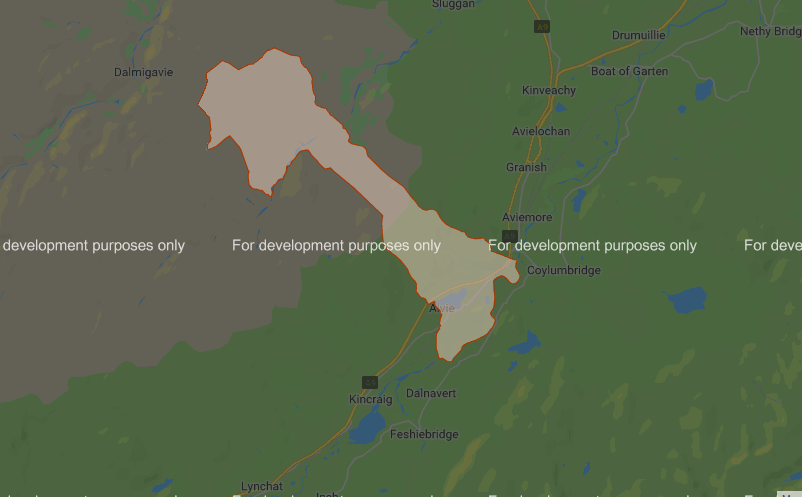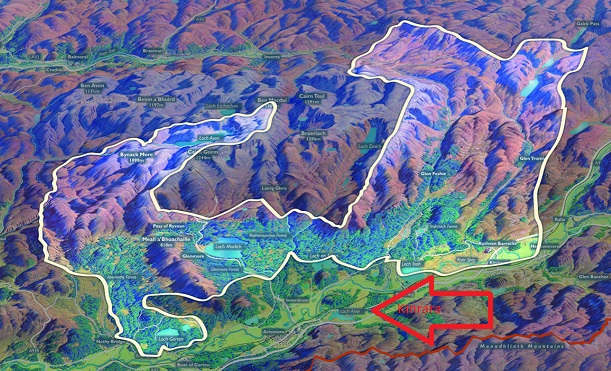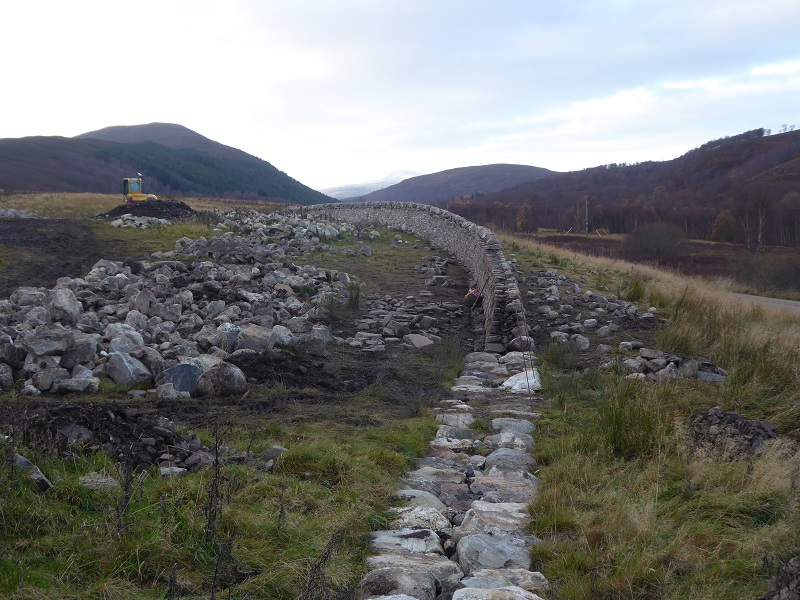The purchase of the Kinrara Estate by Wild Land Ltd, which is owned by Danish billionaire Anders Povlsen, received wide media coverage including from papers who like to treat such matters as part of our celebrity culture (see here). It raises some dilemmas for people who believe that fundamental land reform is needed to address the mismanagement of land by large estates. This post takes a look at the issues.
The first and most basic issue is that its difficult to establish exactly what land has been bought. The media reported that WildLand Ltd has purchased 1,100 acres (or about 1.5 square miles) but Savill’s don’t provide a map on their website (see here). The map on the Cairngorms National Park website shows what appears to be a much wider area than this as owned by Kinrara. This appears to be very out of date because it covers the open hill Savill’s make no reference to grouse moor or deer stalking in their brochure.

[Since issuing this post I have found that the CNPA information is almost ten years out of date. The hill ground, north of Loch Alvie was was sold to the Fletcher family of FES Ltd (Previously Forth Electrical Services) one of Scotland’s richest families – who appear to have made much of their fortune from Public Private contract work (see here). Originally the Fletchers proposed building a new lodge on the estate ground near Ballinluig Farm – north of the A9 – in 2009 but they then purchased Lochindorb Estate in Moray which had a lodge and withdrew the Ballinluig application in 2012)]
The second issue is that there is no information in the public realm about WHY WildLand Ltd have bought this land and what they might intend to do with it – indeed I doubt the Cairngorms National Park Authority or any other public authority knows why.

One possibility is that the estate has been bought primarily for conservation reasons with the estate being very close to the area now being managed under the umbrella of Cairngorms Connect, an alliance between RSPB, Forestry Commission Scotland, SNH and Wild Land Ltd. Another is simply that Mr Povlsen was primarily attracted by the house.
The point is that land in our National Parks is bought and sold without any scrutiny about whether the purchaser intends to manage the land in the public interest.
The short-term consequences of the sale are likely to be positive
The dilemma for people interested in land reform is that the sale is, based on the record of Wild Land Ltd, likely to have some immediate beneficial consequences for conservation, outdoor recreation and the local economy. While I can understand the people who have expressed concern about the purchase (see here and comments below letters) I think many of the fears expressed are in this case groundless.
First, on local employment. While I am not aware of any studies at present about the number of people employed by Wild Land Ltd compared to other estates, I believe they have significantly increased the number of people employed with each purchase they have made. Examples of this on the Feshie group of estates include:
- Renovation of buildings from the Ruigh Aiteachean bothy to the Killiehuntly farmhouse and steading
- The creation of new tourism businesses, e.g at Killiehuntly
- The employment of a team which work full-time on tracks and paths on the estate
- The large deer culls which provide more work for deer stalkers (work which continues year on year as deer invade the estate from surrounding areas)
- Significant tree planting (which again in effect now employs a number of people full-tme
- Large scale surveys of the natural and historic environment on the estate
- Other landscaping work.

This employment is also supporting traditional skills as well as the development of new ones.
Such levels of employment provide a contrast with other estates and are a consequence of the significant investments being made by Mr Povlsen. Although Kinrara appears to include rather different ground, the evidence suggests that whatever Mr Povlsen plans there is likely to create more jobs. An uneasy fact that those who naturally distrust billionaires need to acknowledge. Ackowledging this though leaves open the question about whether private investment is always the best or indeed only way, as is sometimes claimed, of creating such jobs..
The second positive is likely to be on conservation. Most of the land between the A9 and River Spey, which would appear definitely included in the sale, is a Site of Special Scientific Interest. While now old, and maybe out of date, the information from SNH on their sitelink website has this to say:
The upland oak woodland was monitored in 2001 and was found to be in unfavourable condition due to the lack of regeneration and establishment of native tree species. Regeneration of native tree species where it does occur shows signs of high levels of browsing which is thought to be attributable to roe and red deer, rabbits and hares.
The Upland Oakwood is now judged by SNH to be recovering but still not in favourable condition. WildLand Ltd have probably the best record of any landowner of controlling deer numbers in Scotland and, whatever SNH’s current judgement on this site, I would expect them apidly to address any overgrazing issues that remain. So, from a conservationists viewpoint, the sale appears positive.
The gains from an outdoor recreation perspective appear even greater. The Kinrara Estate had a terrible record on outdoor recreation. Indeed the whole reason the Speyside Way does not follow the river here is because of the previous owner’s antagonistic attitudes to walkers. Then last year there was another row when the estate locked gates preventing walkers from accessing the Speyside Way (see here for Scottish Ramblers News Release). The problem behind this is belief that ownership entitles people to exclusive use of land as is illustrated by the Savill’s sales brochure:
The Kinrara Estate lies adjacent to the legendary River Spey, which courses through the Cairngorms National Park in the heart of the Scottish Highlands. The sheer beauty, privacy and spectacular setting of the estate combined with one of the finest Georgian houses in the region all contribute to its reputation as a truly magical estate.
“Sheer privacy” says it all. The good thing is WildLand Ltd has a fantastic record on supporting public access. I have never found ANY sign on any of their estates that tries to deter people from exercising access rights – unlike most other estates. Moreover, estate activities, such as stalking and shooting, are managed around people not by telling them to keep away. I would predict that the longstanding historic access problems at Kinrara will now simply disappear.
There is therefore a lot to be optimistic about for Kinrara in the short-term following this purchase.
The long-term implications of WildLand Ltd’s purchase

The way that Wildland Ltd is currently managing the land it owns offers an example to all, whether private landowners or national conservation organisations (which is not to say there are no concerns (see here)). Landscape scale conservation, through reducing numbers of deer, has been pushed like nowhere else in Scotland with dramatic results in terms of rewilding. In no small part this is due to the resources Anders Povlsen has been prepared to make available to his Conservation Manager, Thomas MacDonnell, to pursue a rewilding agenda.
For me this is encapsulated by six pairs of hen harrier nesting on Feshie this year and three of their nests being lost to predation by foxes. That the predation on raptors is by other wild life, not humans, says it all. While hunting continues in the form of walked up grouse shooting, wildlife of all types is flourishing as the land recovers from decades of overgrazing.
The problem is the National Park has absolutely no control over what might happen in future should Anders Povlsen either lose interest or decide to dispose of the land.
Interestingly, the Cairngorms National Park discussed this very issue when Kinrara was put on the market back in 2004 https://cairngorms.co.uk/sale-of-kinrara-estate/ 2004. The then convener, Andrew Thin, now convener of the Scottish Land Commission, put it in his own inimical way when he said the sale was a purely private matter but also a matter of public interest. That contradiction has not been resolved 14 years later.
The fundamental problem is that large areas of land can be bought in sold in Scotland, even in our National Parks, without any scrutiny (see here for Tulchan case).
The Cairngorms National Park Authority now needs to start considering how it might secure Povlsen’s legacy. A public commitment to engage with him about this would be a good start. After all, we don’t know what he thinks and maybe his long-term plan is to convert WildLand Ltd into a charity whose purpose will be to embed the management principles by which its land is currently being managed in perpetuity?
There are, however, an number of other options the CNPA should be actively advocating/developing:
- The first would be for our National Parks to have a right to veto ANY land sale over a specific size unless the purchaser, whether an individual or an organisation, can show they are fit to own and manage the land. Similar provisions at present apply to services like Care Homes – to run a Care Home you need to pass a fit and proper person test – so if we can do it for that why not our land? This would not prevent WildLand Ltd acquiring land but might prevent people like the previous owners of Kinrara from acquiring more.
- The second is develop mechanisms to ensure that current good management practices, as demonstrated on Glen Feshie, are adopted by any future owners. Our National Parks effectively need to be able to exclude purchasers who were not prepared to continue to invest in the estate and wanted to run it like may other grouse moors and traditional stalking estates. If it was not possible to find a private owner prepared to do this, then any sale would either need to be to a conservation or community organisation that could do so or to the National Park itself. The implication here is that the CNPA, instead of just letting WildLand Ltd get on with it, in the medium terms needs to talk to them about embedding their good practice in formal agreements (on deer numbers etc or maybe as part of a new Nature Reserve agreement)
- The third is to plan for situations where there is no individual or organisation prepared or with the finances to carry on managing the land sustainably. In such circumstances the CNPA should be taking over the land – in other countries land in National Parks is publicly owned – and arguing that the Scottish Government provides the resources necessary to manage it in the public interest.
These matters may seem a long way away, with Povlsen being relatively young, but time passes quickly and people’s interests can change even more quickly. The CNPA needs therefore to engage with Polvsen about the future and more specifically about how conservation management on the estate can be secured in the long term. My suspicion is, if at all interested in leaving a legacy, he would be interested in such discussions as long as they were open ended and open minded.
The thinking that informs and comes out of those discussions however should then be made public and applied much more widely. The biggest challenge the CNPA faces is not to secure the future of estates that are doing the right thing now but rather how to tackle those which aren’t, either through allowing deer numbers to remain far too high or through intensive grouse moor management. A framework for securing sustainable land management in the National Park needs to be applicable to either extreme.
What you say, Nick, in this blog about having environmental controls on future large land transactions, particularly within National Parks is absolutely right. In my cynical mind, your ideas are too far reaching for our National Parks and our Scottish Government to consider – but I’m very happy to be proved wrong. Our National Parks will just say that they don’t have the powers to do this, but the response should be, so what are you don’t to get these powers?
There is much talk about regulatory controls over estates where deer numbers are out of control and where intensive grouse moor management is having a detrimental effect on plant and animal diversity, but apart from showing what can be done on estates like Glen Feshie, there seems to little if no progress being made in Government. Remember the words of shock that Nicola Sturgeon said in the early Spring about the culling of mountain hares – since then nothing seems to have happened. Were these just empty words spoken at a convenient moment?
What is important is to keep these ideas going in public debate, otherwise our politicians will just ignore them.
I see the estate is on the market again, but a larger acreage and price.
While I agree with some of what you say above re conservation and benefits, the main point is, apart from the sale and purchase of large estates with no political oversight, or public interest involved, is that the management of these landholdings is entirely at the whim of the owner. The Scottish public, local people, those living or working on the estate or having other connections have absolutely no say whatsoever in how the land is managed.
They can be managed badly, for grouse and deer shooting, or managed better for conservation and employment, but in either case we have no input. Any billionaire can come in and live out their personal “back to nature” fantasy, or live the “sporting” life of an old world aristocrat and we can do nothing about it.
So whatever the benefits or disbenefits, the main imperative is that the people of Scotland must have their say.
Graham, Surely the people of Scotland do have their say. All sorts of official bodies and ministries are in place across Scotland. Elected officials are supposed to ensure for the people of Scotland that what may take place on privately owned property does comply with the law. The remits of statutory authority: SEPA, NatureScot ( or whatever the Dept of Environment in Scotland decides to ‘brand’ itself as .. this week…) Historic Scotland, Local planning policy, agricultural grants and subsidy regulation – all reflect imperatives of public policy. ) If the public wish to question how things happen now, they must become wise enough..much wiser than now. The electorate must engage with elected politicians. They public must elect to public office only those who demonstrate a clear willingness to tackle negligent , and “incestuous” control of land. There is now a huge backlog of misapplication of human resources across Scottish Councils and ministries. Even Audit Scotland appears incapable of holding councils and ministries to account. The diversion and squandering of public money on enquiry “learning lessons through mistake ” would be unnecessary if Scottish Ministers attended to their various roles efficiently, without fear or favour. That so many through this past decade do not see much need to do this properly reflects straight back on those who elected/appointed them.